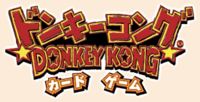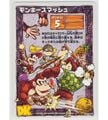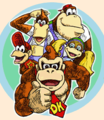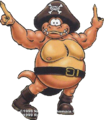Donkey Kong Card Game (trading cards)
The Donkey Kong Card Game[1] is a Japanese series of trading cards based on the Donkey Kong Country cartoon television series and Donkey Kong 64. It can be played as a two-player game with rules based on rock-paper-scissors. It began to be commercialized on December 10, 1999.[2] The trading cards and related material were manufactured by Ahomaro Games in collaboration with Nintendo and Rare.
Packs[edit]
At launch, the cards were sold in a Starter Pack of 60 cards and a Booster Pack of 10 cards among a set of 252 cards.[1] A second Booster Pack was later released, called the Chunky Pack, which always includes a Chunky Kong card and a Kritter card along with 8 other cards.[3] Finally, in August 25, 2000 was released a third Booster Pack called the DK64 Pack,[4] which contains 10 cards from a new set of 72 cards based on Donkey Kong 64.
Cards[edit]
There are three types of cards: character cards, move cards, and support cards. The border color on the back of cards is yellow for character cards and red for other cards.
Character cards[edit]
A character card (キャラクターカード) is used by one player over the course of one round. It has three statistics: P (power), H (hand), and S (speed). P and S determines which move cards can be used during the round, with S also determining which player starts the round, and H represents the number of cards that the player can draw at the start of a round. A character card may also have an associated effect that triggers at the start of a round. Many character cards have a shiny variant with different illustrations but identical name and statistics.
Furious King K. Rool
Candy Clone (shiny)
Move cards[edit]
Move cards (
There are three attack cards: punch (パンチ), kick (キック), and throw (なげわざ), each of which correspond to a rock-paper-scissors gesture that is depicted on the card. Punch corresponds to rock, kick corresponds to paper and thus can counter punch, and throw corresponds to scissors and thus can counter kick but can be countered by punch. The DK64 Pack also includes combination cards (がったい) that combine two gestures.
Defense cards (ぼうぎょ), represented by a finger pointing down, can be used to cancel an opponent's attack without taking any damage. Placing one immediately ends the turn.
Pineapple Launcher (throw)
Support Cards[edit]
Support cards (サポートカード) can only be played at the start of a turn. When placed, they immediately cause a specific effect and end the turn.
Gameplay[edit]
At the start of a game, each of the two players builds a deck of cards that is comprised of 40 move and support cards, that must be shuffled and make up the stock pile, and 5 character cards that can be ordered to the player's liking and must be placed as a small pile. At the start of a round, each player draws a character card then draws from the stock pile a number of cards equal to the H statistic of the card. Each player can have at most 10 cards in hand. The player whose character card has the highest S number goes first.
At the start of a turn, the first player can either pass, place a support card, or place an attack card. In the latter case, the second player may use a defense card or counter the attack with an adequate attack card, in which case the first player can use a defense or attack card too. The second player cannot counterattack a second time, and may only use a defense card. If a player does not counter an attack, they will have to discard a number of cards from their stock pile equal to the damage number specified on the attack card; also, an additional effect may trigger. Once the turn is over, it is the second player's turn and roles are reversed.
If a player passes (for example, if they cannot place a card), they rotate their character card by 180°, effectively directing it towards their opponent. They also will not be able to place an attack card at the start of their turns until the end of the round. If the total number of times any of the two players have passed during a round reaches two, then the round is over: both players discard their character cards and draw another one. If the character card piles become empty, each player can take back their discarded character cards and reorder them into a new pile.
The games ends when a player receives damage while their stock pile is empty, in which case the opponent wins the game.
Gallery[edit]
- For this subject's image gallery, see Gallery:Donkey Kong Card Game (trading cards).
Artwork showing the five playable Kongs in Donkey Kong 64
Eddie the Mean Old Yeti artwork
Kaptain Skurvy artwork
Names in other languages[edit]
| Language | Name | Meaning | Notes |
|---|---|---|---|
| Japanese | ドンキーコングカードゲーム[5] Donkī Kongu Kādo Gēmu |
Donkey Kong Card Game |
References[edit]
- ^ a b December 1, 1999. DK Card Game Announced. IGN (English). Retrieved February 9, 2025.
- ^ 1999-2000. Donkey Kong Card Game. Nintendo Co., Ltd. (Japanese). (Archived May 25, 2006, 06:04:37 UTC via Wayback Machine.)
- ^ 1999-2000. Product lineup. Nintendo Co., Ltd. (Japanese). (Archived May 3, 2006, 16:22:03 UTC via Wayback Machine.)
- ^ 2000. Topics. Nintendo Co., Ltd. (Japanese). (Archived September 13, 2007, 13:38:37 UTC via Wayback Machine.)
- ^ Official logo
External links[edit]
- Official Japanese website (accessed through archive.org)























